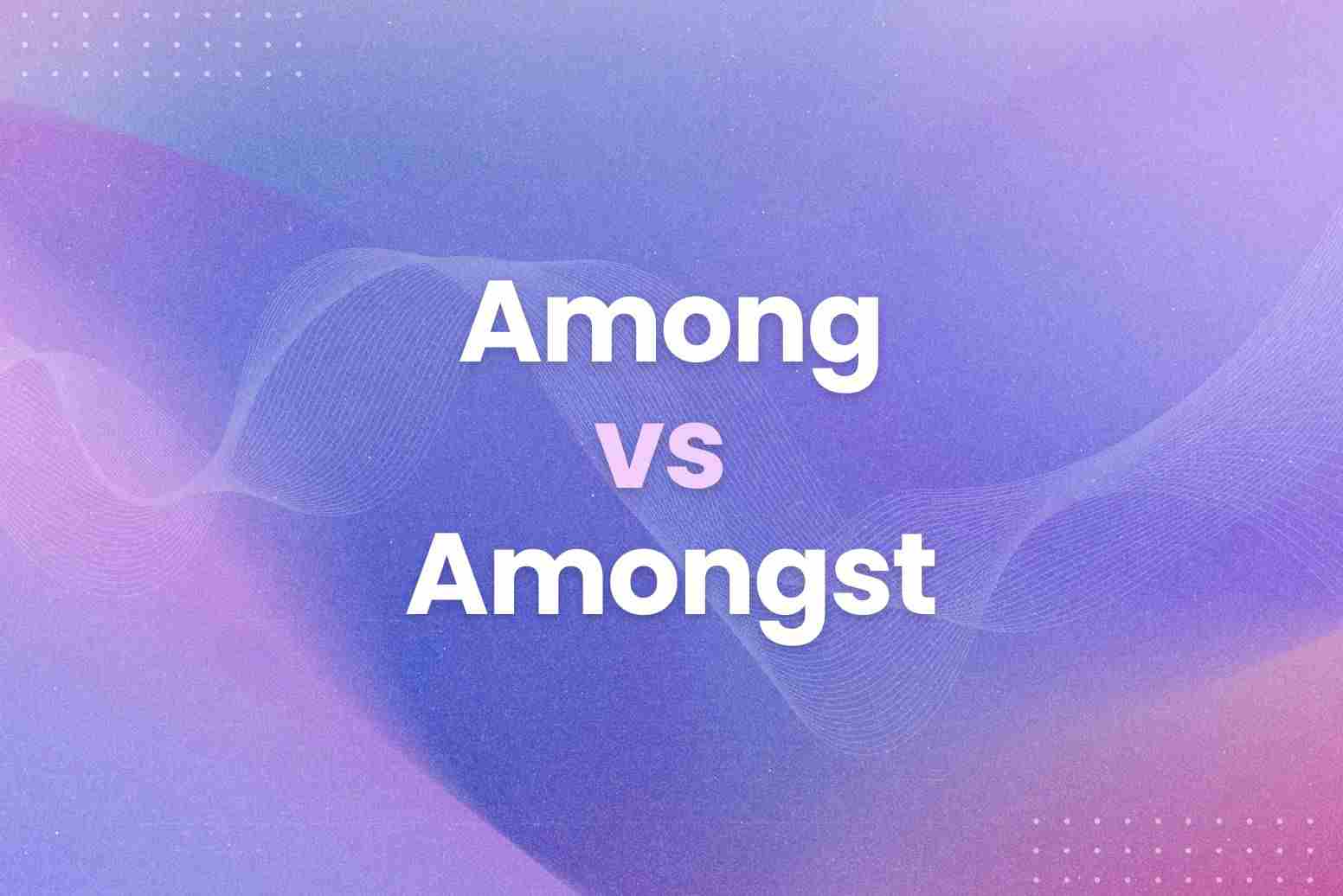Ever get that nagging feeling when you’re writing, like something’s not quite right? Maybe it’s a tricky grammar point that just trips you up every time. We’ve all been there. One common head-scratcher is the difference between among vs amongst. They seem interchangeable, right? Well, not always.
In this guide, we’ll break down these two words, explore their subtle differences, and give you the knowledge to use them correctly. Here’s what we’ll cover on among vs amongst:
- Definitions and examples of both “among” and “amongst”
- Key differences and when to use each word
- A quick history lesson on these tricky terms
- Common mistakes to avoid (and how to fix them)
Let’s find out.
Let’s Define “Among”
“Among” is a preposition that indicates a relationship involving three or more people or things. Consider it as highlighting a sense of being within a group or surrounded by something.
Examples:
- The marbles were divided among the children.
- There was a sense of excitement among the crowd.
- The decision caused disagreement among the team members.
See? It’s all about showing that something is happening within a group. Pretty straightforward, right?
Now for “Amongst”
“Amongst” is basically the same as “among,” with a slightly old-fashioned flavor. It also indicates a relationship involving three or more entities. Imagine it as “among’s” slightly fancier cousin. You might find it in older texts or formal writing.
Examples:
- The secret was shared amongst the members of the society.
- There was a sense of unease amongst the guests.
- The treasure was hidden amongst the trees.
Notice how “amongst” adds a touch of formality to these sentences? That’s its power.
Among vs Amongst: Spotting the Difference
We know that both “among” and “amongst” deal with groups of three or more. But, what makes them different? It mostly comes down to style and a bit of history.
Style and Tone
- “Among” is the more common choice in modern English, especially in everyday conversations and informal writing. It’s like your go-to pair of jeans – comfortable and versatile.
- “Amongst” tends to appear in more formal settings, like academic papers, legal documents, or literature with an old-timey feel. It’s more like a tailored suit – you wouldn’t wear it to a barbecue, but it’s perfect for special occasions.
A Dash of History
“Amongst” is older than “among.” It popped up in the Middle Ages, while “among” came into fashion a bit later. Over time, “among” became the more popular choice. Still, “amongst” stuck around, adding a touch of elegance to certain writing styles.
When to Use Which
- Use “among” when you want to keep things casual and straightforward. Whether you’re writing a blog post, a quick email, or just chatting with friends, “among” is your friend.
- Use “amongst” when you need a more formal or literary tone. It’s a great choice for academic essays, official reports, or when you want to channel a classic vibe.
Need a little extra help deciding which word fits best? Arvin can be a lifesaver. This AI-powered browser extension uses the smarts of GPT-4 to analyze your writing and suggest the perfect word choice. It’s like having a grammar guru right in your browser. Check out Arvin’s grammar function – it can make a big difference in your writing.

A Quick History Lesson On These Tricky Terms
Both among and amongst have roots in Old English. “Among” comes from the word onmang, which meant “in a crowd.” It first appeared around the 12th century and quickly gained popularity.
“Amongst,” on the other hand, is a bit older. It entered the scene in the Middle Ages, evolving from the Old English word ongemang, which also meant “in a crowd.” Fancy, right?
As the English language evolved, “among” became the more common choice. But “amongst” stuck around, adding a touch of old-world charm to formal writing. It’s like a linguistic time capsule.
That’s a glimpse into the history of these two words. Who knew prepositions could have such an interesting backstory?
Common Among vs Amongst Errors
Even though “among” and “amongst” seem pretty simple, there are a few common traps you can fall into. But don’t worry, we’ll help you steer clear.
Using “Amongst” in Casual Contexts
Remember how we said “amongst” is like a fancy suit? Well, you wouldn’t wear a suit to the beach, right? Similarly, avoid “amongst” in casual writing or everyday conversation. It can sound a bit out of place.
Example Fix:
- Incorrect: “We split the pizza amongst ourselves.”
- Correct: “We split the pizza among ourselves.”
Overusing “Amongst”
Even in formal writing, don’t go overboard with “amongst.” While it adds a touch of sophistication, using it too much can make your writing sound stuffy and old-fashioned.
If you’re unsure whether “amongst” fits, try replacing it with “among.” If the sentence still sounds good, stick with the simpler option.
Confusing “Among” with Other Prepositions
Sometimes, writers mistakenly use “among” when another preposition would be a better fit.
Example Fix:
- Incorrect: “I walked among the river.”
- Correct: “I walked along the river.”
Become an Among vs Amongst Guru with Arvin
In conclusion, you’ve got the lowdown on “among” and “amongst”. No more second-guessing yourself – you’re ready to use these words like a pro.
Here’s a quick recap of what we covered:
- “Among” is the more common choice for everyday writing.
- “Amongst” adds a touch of formality.
- Both words involve groups of three or more.
- Watch out for common mistakes, like overusing “amongst.”
Want to take your grammar skills to the next level? Arvin is here to help. For instance, our AI-powered browser extension can give you instant feedback on your writing. Moreover, it can suggest the best word choices and even help you avoid those pesky grammar gremlins. Consequently, with Arvin by your side, you’ll be writing with confidence in no time.
FAQs
“Among” is generally the preferred choice in modern English. It’s more common and versatile. However, “amongst” can be used in formal writing or when you want to create a more old-fashioned tone.
In this case, “among girls” is the better choice. Since this is a common, everyday phrase, it’s best to stick with the more common preposition.
Again, “among the crowd” is the more natural-sounding option. “Amongst” would sound a bit too formal in this context.
Certainly. Here’s an example where “amongst” fits well:
“The rumors spread quickly amongst the villagers.”
In this sentence, “amongst” adds a slightly archaic feel, which might be appropriate if you’re writing a historical novel or a piece with a classic tone.






